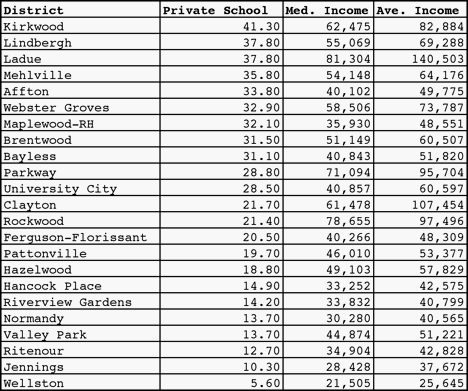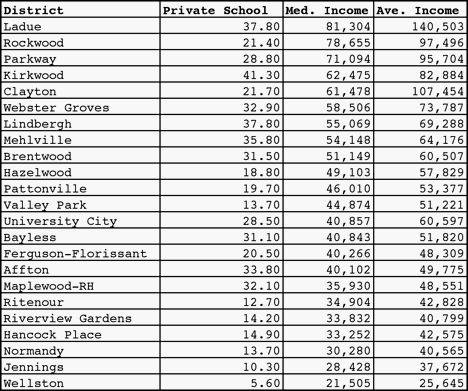Hazelwood School District
Longer school year?
03/11/09 16:17 Categories: Policy
Arne Duncan is looking at longer school days or years to help improve our country’s education and to help our students compete in a global economy in which many countries such as India and China go 20 to 30 days more a year. I’m sure students won’t like this idea, I doubt teachers will, and I’m not confident parents will either. However, I think that we should consider a longer school year.
I was at a committee meeting last night at my children’s elementary school in which the principal was telling us about a decision made to change the allocation of minutes. Every addition of time is a trade-off. Adding more minutes to the school day isn’t necessarily the best decision since young children need some time to play, but a longer year would ease the minute turf war and reduce summer retention problems.
The parents at the meeting kept asking about when the teachers were able to meet together district-wide by grade level. Teaching has traditionally been a solitary profession but is increasingly team-oriented as planning is done in groups. To facilitate this districts need to provide time for teachers to meet in various teams. Some districts do better at this than others, but all of them need to do more.
School year length ranges from 190 days for Farmington to 167 for Wheatland in Hickory County and Appleton City in St. Clair County. The St. Louis city and county districts have a narrower range from 174 to 178 with Ritenour as an outlier at 182 (good for it!). (Numbers from DESE)
The length of school day in St. Louis county and city ranged from 6.6 in Kirkwood (with quite a few districts at 6.5) to Jennings at 6.0. Jennings has a shorter day and one of the shorter years, but other districts mixed the two. For example, Clayton has one of the longer years but shorter days to allow for after school teacher meetings. Some of the districts such as University City and Bayless had a longer day at 6.5 hours but relatively shorter year at 175 days. Kirkwood, Ladue and Ritenour have students attending the most hours. Jennings and Hazelwood are at the bottom.
The number of hours taught ranged in the state from a high of 1209.5 (Centerville in Reynolds County) to 1014.5 (Calhoun in Henry County).
I predict that the we don’t have a significant change in the next couple of years but a quickening of the incremental pace we’ve been having in the increase of time as pressures mount on districts to improve. The state will need to come in and establish minimums for the rural areas that don’t face the same competition.
Science: What gets tested gets taught
10/13/08 09:45 Categories: Science | Assessment

Photo by Adam Baker
Since the MAP is including science now, schools are increasing their focus on teaching science although I’m not sure they have enough.
All of this comes as economic and education experts worry about U.S. global competitiveness.
“We should be embarking immediately on an all-hands-on-deck, no-holds-barred, no budget-too-large crash program for science and engineering education.” (Thomas L. Friedman in The World is Flat 3.0)
Missouri needs to increase its state requirements for graduation. All students need to take biology, chemistry and physics (not necessarily in that order). Students graduating in 2010 are required to take three years (same as math and history), which is an increase from the currently required two years. I think all students should take four years of all four core subjects. Most schools don’t require physics, but the concepts are essential in science and can be taught to all. (See previous post on teaching physics first.)
For example, Hazelwood currently requires students to take Physical Systems and Chemical Systems, each a semester course. Then students are required to take biology for a year. This includes students with a College Prep designation on their diploma. With the requirement increase, students are then required to add another year of science of their choice. Only one semester of chemistry? They offer a full year of chemistry but don’t require it. This is not enough science for people competing with other countries for jobs and deciding on the direction of science via elections.
Francis Howell currently requires a year of physical science and a year of biology. Chemistry and physics are optional.
Elementary schools need to increase the emphasis on science and integrate science with math and reading.
MRH, which has a helpful curriculum online, does not include science K-5. Is it not important enough?
Rockwood does include a grade-by-grade detailed list of its science curriculum starting at the K level. It also puts on a Science Expo at the beginning of the year to stir up excitement and let the students and parents know of science resources available in St. Louis.
Mehlville doesn’t include the detail that Rockwood does, but it gives an easy to decipher overview of the content covered in each grade, the name of the textbook used (!) and suggested resources and activities for families. As an educator I like the Rockwood detail, but the Mehlville overview is definitely more readable. I would like districts to include both.
I looked at the 2008 MAP 5th grade science scores comparing median MAP scale scores. None of the top 10 in the state were in the St. Louis metropolitan area, but none of them had more than 27 students taking the test, so I narrowed my list to districts in the metropolitan area, including charter schools. The top school districts were not surprising, but I was intrigued by some of the districts on the list such as Washington, Windsor and Fox. Parkway was 16th. Union and Festus were 11 and 12.
| DISTNAME | MEDIAN_SCALE_SCORE |
| ROCKWOOD R-VI | 684 |
| LADUE | 682 |
| KIRKWOOD R-VII | 680 |
| CLAYTON | 680 |
| LINDBERGH R-VIII | 677 |
| BRENTWOOD | 676 |
| WEBSTER GROVES | 676 |
| WINDSOR C-1 | 674 |
| FOX C-6 | 674 |
| WASHINGTON | 673 |
I then searched to see if the same districts had the highest number of students scoring at the advanced level.
| DISTNAME | ADVANCED_PCT |
| ROCKWOOD R-VI | 39.6 |
| LADUE | 36.2 |
| CLAYTON | 30.2 |
| KIRKWOOD R-VII | 28.9 |
| WEBSTER GROVES | 28.5 |
| LINDBERGH R-VIII | 25.4 |
| ORCHARD FARM R-V | 22.9 |
| WASHINGTON | 22.3 |
| FOX C-6 | 22.2 |
| JEFFERSON CO. R-VII | 20.2 |
Most of the districts were the same with Orchard Farm joining the list and Windsor falling to 11. Parkway moved up to 12.
Sorting by median Terra Nova scores shuffled the districts a bit bringing New Haven (Franklin Co. R-II) into the top.
| DISTNAME | MEDIAN_TERRANOVA |
| ROCKWOOD R-VI | 82.0 |
| CLAYTON | 81.0 |
| BRENTWOOD | 80.0 |
| KIRKWOOD R-VII | 79.0 |
| LADUE | 77.0 |
| FRANKLIN CO. R-II | 77.0 |
| WEBSTER GROVES | 76.0 |
| UNION R-XI | 74.0 |
| FOX C-6 | 73.5 |
| LINDBERGH R-VIII | 73.0 |
Rockwood comes out on top in every configuration. Whether it is the Science Expo, detailed expectations or another reason altogether, the elementary schools there come ahead.
I’ll be interested to watch whether this new focus on science raises everyone’s scores.
Students taking AP classes in Mo., or not
02/15/08 22:57 Categories: Other
My Humps—Calculus
Students in Missouri are not taking AP courses at nearly the same levels as in other states according to the College Board annual report released earlier this week (Wed. Feb. 13). In Mo. 10.6 percent of students take an AP class versus 24.9 percent national average. We're at less than half the national average.
Nationally, 15.7 percent of students earn a 3 or higher on at least one AP exam; whereas, in Mo. only 6.7 percent do. In fact, Mo ranks 46th. (Yeah, the College Board recommends against ranking for a lot of valid reasons, but I did I did it anyway.)
Last summer, Mo. DESE sent out a press release praising the uptick in numbers of students taking the exam.
❝This year we sent more money to Missouri classrooms than ever before and also secured funding to encourage even more students to take AP classes, including training for more AP teachers and assistance to help cover the cost of AP exams. It is clear by our students’ outstanding performance that our investments are helping our students prepare for the challenges ahead,❞ he [Gov. Matt Blunt] said.
However, the 2.0 percent increase in the past 5 years is quite a bit less than the national average of 3.5 percent increase. Our students are falling behind.
It's possible students here are taking AP courses but not the exam. Adding in IB classes wouldn't raise the rates much since only a few high schools here offer them (Lindbergh, Metro). However, I wonder if St. Louis University's 1-8-1-8 program decreases students motivation to take the AP exam.
I couldn't find numbers on students in Mo. taking AP courses, but I did look up a few districts' offerings to compare to the national average (9). Clayton offers 21 AP courses including Calculus BC, Music theory and Macroeconomics. Hazelwood offers 15 including Computer Science and Physics. I also looked up a rural district and chose DeSoto at random. I couldn't find evidence they offered any AP courses. I didn't see any listed in the course schedule (except possibly calculus); nor were any mentioned in the student handbook. They are proposing a college prep certificate starting class of 2010. If that is reflective of rural districts, Mo. is in trouble.
Missouri has started two centers at Truman and SeMo to help train teachers to teach AP courses. This is a good start but not enough.
Why go private? Income? Religion? Ivy League?
12/18/07 15:43 Categories: Private Schools

Region plays a large role in the private school rate as Mehlville and Affton have a higher private school rate than wealthier west county districts. It’s a Catholic area, baby! (Lutheran South may have a role in the numbers for Affton.)

My theory is that the private school rate is dependent on multiple factors such as tradition, income and strong private school presences.
Ladue and Clayton are often considered sister schools with similar test scores, rankings, size, finances etc. However, the private school rates differences are striking. Yes, CBC moved to west county, but that was after the 2000 census. (Will these numbers change greatly in 2010?) I would have to dig more to figure out what Clayton and Rockwood have in common that is different than Ladue. I don’t know if Clayton’s numbers are related to the high number of people who walk or ride their bike to work, but I imagine Ladue’s high numbers are related to the two Ivy league feeder private schools within its borders. This is the land that inspired Confessions of a Prep School Mommy Handler by Wade Rouse.
Yes, of course, there’s a general correlation to income although the exceptions are more interesting.

Look at Hazelwood and Brentwood with similar median incomes but different private schools rates or Affton and Ferguson-Florissant. I think the North County region just doesn’t have the tradition of attending private schools at the same rate. It’s not income there.
Why is Lindbergh’s private school rate (top 3) higher than it’s median income or quality would lead someone to hypothesize? I’m going back to the Catholic tradition.
Why is Kirkwood, a high quality school district, the number one private school sender? It’s not in the top three wealthiest by median or four by average. It’s numbers are more in line with Webster or Lindbergh. By tradition I would have put it with Webster, but, apparently, it aligns more with Lindbergh.
I have so many ideas for more posts now—how about that ranking of school districts by how many people go to work by walking or biking? Is there any significance that I can pull out from that? Who knew I could find census data so entertaining.
White Flight? Let's look at those test scores
12/13/07 18:19 Categories: NCLB
The St. Louis Post-Dispatch printed an interesting article on white flight affecting the Hazelwood School District. The Libertarian-styled think-tank Show-Me Center's education blogger, Sarah Brodsky, responded that maybe people were leaving the district because of state test scores.
So I looked up the state test scores. Most of the population shift has been to St. Charles, so that was my comparison.
St. Charles
Comm 49.4 met 2 of 7 targets
Math 49.4 met 2 of 7 targets
Graduation rate 81.3
Hazelwood
Comm 34 met 2 of 8 targets
Math 30.2 met 4 of 9 targets
Graduation rate 83.9
District improvement level 1
Hazelwood West
Comm. 43.2
Math 33.9
While people in St. Louis are a bit jaded on the whole AYP since even the wealthy districts can't meet all their targets, neither of these districts have numbers to brag about. (Although in fairness, they could also be much worse.) Yes, St. Charles has higher scores than Hazelwood, but I don't see that they justify mass movement. If you look at Hazelwood West's scores, the focus school of the article, they are closer especially in reading. I suspect other factors are in play.
❝The whites may be moving to districts that do better than Hazelwood on the state tests.❞
So I looked up the state test scores. Most of the population shift has been to St. Charles, so that was my comparison.
St. Charles
Comm 49.4 met 2 of 7 targets
Math 49.4 met 2 of 7 targets
Graduation rate 81.3
Hazelwood
Comm 34 met 2 of 8 targets
Math 30.2 met 4 of 9 targets
Graduation rate 83.9
District improvement level 1
Hazelwood West
Comm. 43.2
Math 33.9
While people in St. Louis are a bit jaded on the whole AYP since even the wealthy districts can't meet all their targets, neither of these districts have numbers to brag about. (Although in fairness, they could also be much worse.) Yes, St. Charles has higher scores than Hazelwood, but I don't see that they justify mass movement. If you look at Hazelwood West's scores, the focus school of the article, they are closer especially in reading. I suspect other factors are in play.